
Churches - Bevendean History Project
St Mary Magdalen Church, Bread StreetThis
church was the first church in Brighton to have the name St Mary
Magdalene and was built by the Rev. Arthur D. Wagner, the Vicar of St.
Paul's who was the son of the Vicar of Brighton.
Rev. Wagner paid for the work at a cost of £2,500 and the church was licensed for worship but never consecrated. St. Mary Magdalene was one of three temporary churches, which the Rev. Wagner built to the Glory of God and the furtherance of His work.
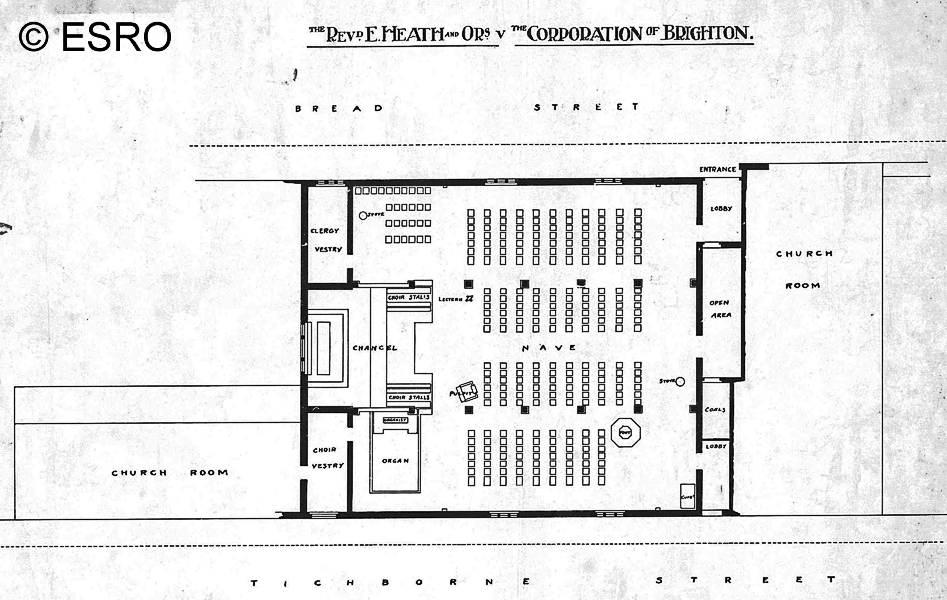
A plan of the church drawn in 1908.
As a temporary mission church, St. Mary Magdalene was built in a district of mainly lower class people. Many of the streets running between North Road, Church Street, and Gloucester Road, were very poor, and Bread Street was one of the poorest of these.
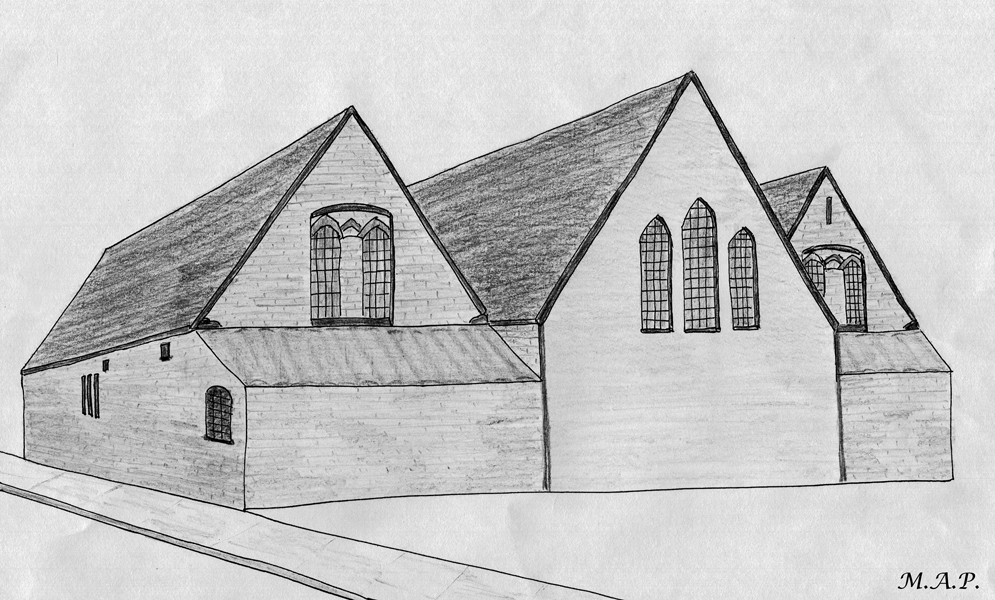
Sketch of St Mary Magdalen Church from Bread Street soon after completion.
Although the church was architecturally very plain, great pains and loving care were bestowed on its interior arrangements to render it ‘neat, chaste, and beautiful, as befitting the high purpose it was designed for’. The church consisted of a nave and two side aisles all open to the roof. The aisles were separated from the nave by plain square pillars of wood, supporting the roof. The seats were plain chairs with suitable hassocks. The font was plain, as was the pulpit, more accurately described as a preaching lectern, and a litany stool faced the altar. The walls were of white-washed brick, the colour being relieved by the red curtains of the aisle windows, and by the pictures depicting scenes in the life of our Lord.
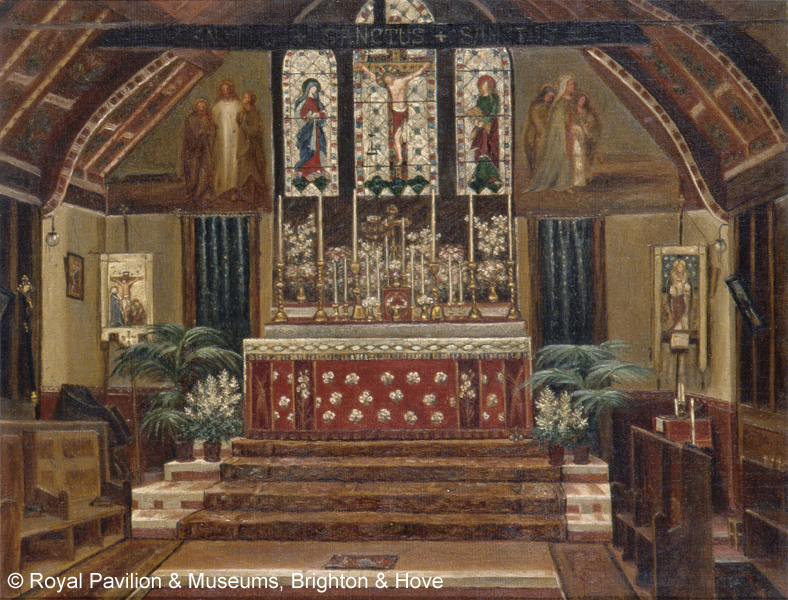
"Interior of St Mary Magdalene, Bread St, Brighton", a painting by George Frederick Bodley, showing the altar with stained glass windows above and murals to either side. Dated 1862.
Image from the Royal Pavilion & Museums Image Store, © 'Royal Pavilion & Museums Brighton & Hove'.
The pillars of the nave were adorned with illuminated shields, representing various Saints and sacred personages mentioned in Holy Writ. The choir stalls were also very plain. In contrast to the simplicity of the nave and aisles the sanctuary was remarkable beautiful. Approached by five richly grand steps the altar was surrounded with the decoration of high ritual. There were two large stands for lights and on either side, richly-worked banners. Besides the sacred emblem of the Cross, there were the usual lights, and flowers, the latter generally the richest and most beautiful available. The altar was vested with a frontal and covers suitable to the various seasons of the Christian year and at the back hung a rich dossal cloth. The roof was slightly decorated to distinguish it from the nave, and seven lamps were suspended from the roof. In the wall behind the altar was a small but vivid and beautiful east window with three lights. The centre represented our Lord on the Cross, and the side ones each depicted one of the holy women. The church presented all the symbolic adornments expected, and yet was neat and plain; giving a feeling of quiet reverence being a place sanctified to the highest worship of the Almighty.
The church was opened by license on the 13th Oct. 1862. When the choral service was led by the choir from St. Paul's, and the church was served by the clergy of St. Paul’s. Rev. Wagner retained it under his own jurisdiction, as a mission church to his own beautiful parish church, and occasionally assisted in the services himself.
The seating accommodation at St. Mary Magdalene was for 700 people, and all the seats were free. In January 1875 the church was reported as being ‘pretty well attended’, and the congregation joined in the services with ‘heartiness and earnest devotion’. There was a ‘tolerably good’ choir and although the organ was ‘a decidedly inferior instrument’, it still answered its purpose. The services were full choral, with the Gregorian tones being used. The demeanour of the congregation was noticeable as being most devout and reverent.
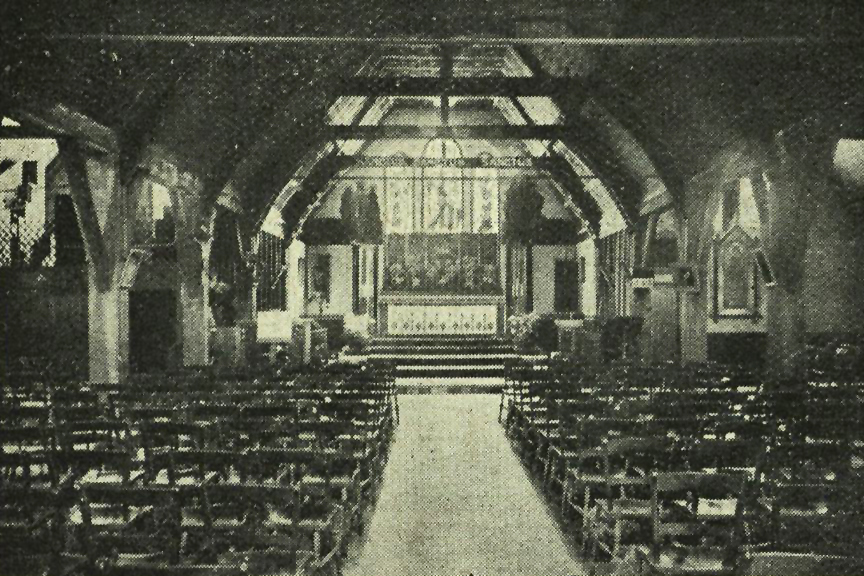
Interior view of St Mary Magdalen Church in Bread Street
On Sundays there were services at 7.30am, 10.30am, 4.00pm and 7.00pm. There were no high celebrations of the Holy Communion at the Church, except upon great festivals, but vestments were worn at the low celebrations, which were at 7.30am on Sunday, Wednesday, and Friday mornings, and on the mornings of Saint Days. At 10.30am on Sundays there was a choral matins with sermon, litany at 4.00pm and evensong with sermon at 7.00pm. On week days evensong was daily at 8pm, but there was no daily matins. In 1875 St Mary Magdalene had a Sunday school with a little over 200 scholars, including boys, girls, and infants.
The church was never enlarged nor did it become parochial, which was not surprising as there were several other churches within a short distance. By 1929 it was little used and was closed in 1948 then demolished.
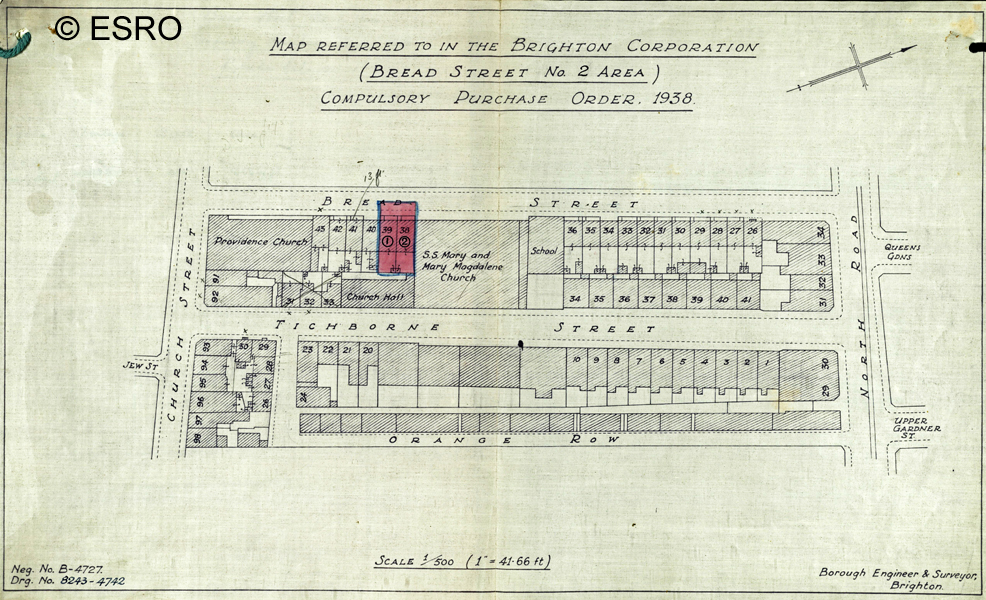
Houses and buildings between Bread Street and Tichborne Street showing the position of St Mary Magdalen Church, plan dated 1938.
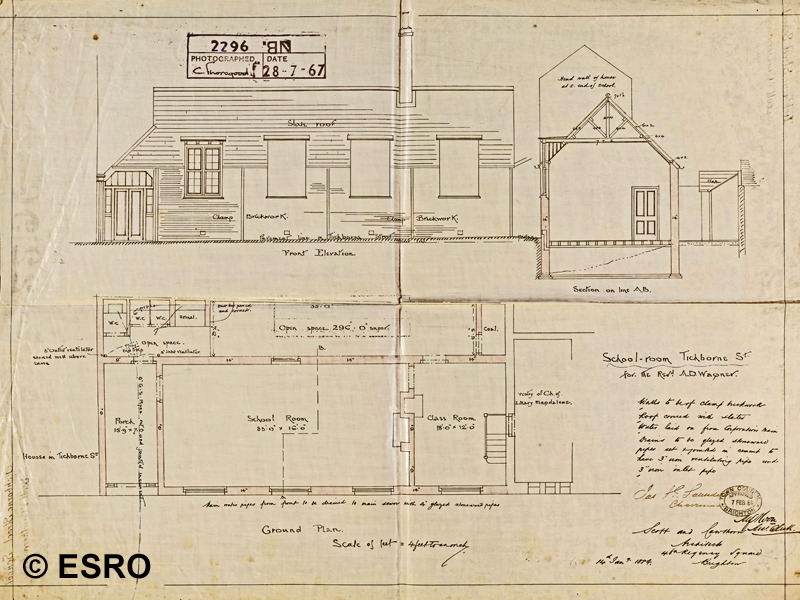
Plan for a school room adjacent to St Mary Magdalen Church in Tichborne Street for Rev A. D. Wagner dated 14th January 1884.
The original site of the church has become lost in the extensive redevelopment of the Church Street area and the disappearance of most of Bread Street, which ran between Spring Gardens and Tichborne Street.
The dedication and some of the fittings from the church in Bread Street were transferred to the new St Mary Magdalene's, built by the conversion of a farm barn in Coldean Lane.
St Mary Magdalen Church Bread Street in 1914
Rev. Wagner paid for the work at a cost of £2,500 and the church was licensed for worship but never consecrated. St. Mary Magdalene was one of three temporary churches, which the Rev. Wagner built to the Glory of God and the furtherance of His work.

A plan of the church drawn in 1908.
As a temporary mission church, St. Mary Magdalene was built in a district of mainly lower class people. Many of the streets running between North Road, Church Street, and Gloucester Road, were very poor, and Bread Street was one of the poorest of these.

Sketch of St Mary Magdalen Church from Bread Street soon after completion.
Although the church was architecturally very plain, great pains and loving care were bestowed on its interior arrangements to render it ‘neat, chaste, and beautiful, as befitting the high purpose it was designed for’. The church consisted of a nave and two side aisles all open to the roof. The aisles were separated from the nave by plain square pillars of wood, supporting the roof. The seats were plain chairs with suitable hassocks. The font was plain, as was the pulpit, more accurately described as a preaching lectern, and a litany stool faced the altar. The walls were of white-washed brick, the colour being relieved by the red curtains of the aisle windows, and by the pictures depicting scenes in the life of our Lord.

"Interior of St Mary Magdalene, Bread St, Brighton", a painting by George Frederick Bodley, showing the altar with stained glass windows above and murals to either side. Dated 1862.
Image from the Royal Pavilion & Museums Image Store, © 'Royal Pavilion & Museums Brighton & Hove'.
The pillars of the nave were adorned with illuminated shields, representing various Saints and sacred personages mentioned in Holy Writ. The choir stalls were also very plain. In contrast to the simplicity of the nave and aisles the sanctuary was remarkable beautiful. Approached by five richly grand steps the altar was surrounded with the decoration of high ritual. There were two large stands for lights and on either side, richly-worked banners. Besides the sacred emblem of the Cross, there were the usual lights, and flowers, the latter generally the richest and most beautiful available. The altar was vested with a frontal and covers suitable to the various seasons of the Christian year and at the back hung a rich dossal cloth. The roof was slightly decorated to distinguish it from the nave, and seven lamps were suspended from the roof. In the wall behind the altar was a small but vivid and beautiful east window with three lights. The centre represented our Lord on the Cross, and the side ones each depicted one of the holy women. The church presented all the symbolic adornments expected, and yet was neat and plain; giving a feeling of quiet reverence being a place sanctified to the highest worship of the Almighty.
The church was opened by license on the 13th Oct. 1862. When the choral service was led by the choir from St. Paul's, and the church was served by the clergy of St. Paul’s. Rev. Wagner retained it under his own jurisdiction, as a mission church to his own beautiful parish church, and occasionally assisted in the services himself.
The seating accommodation at St. Mary Magdalene was for 700 people, and all the seats were free. In January 1875 the church was reported as being ‘pretty well attended’, and the congregation joined in the services with ‘heartiness and earnest devotion’. There was a ‘tolerably good’ choir and although the organ was ‘a decidedly inferior instrument’, it still answered its purpose. The services were full choral, with the Gregorian tones being used. The demeanour of the congregation was noticeable as being most devout and reverent.

Interior view of St Mary Magdalen Church in Bread Street
On Sundays there were services at 7.30am, 10.30am, 4.00pm and 7.00pm. There were no high celebrations of the Holy Communion at the Church, except upon great festivals, but vestments were worn at the low celebrations, which were at 7.30am on Sunday, Wednesday, and Friday mornings, and on the mornings of Saint Days. At 10.30am on Sundays there was a choral matins with sermon, litany at 4.00pm and evensong with sermon at 7.00pm. On week days evensong was daily at 8pm, but there was no daily matins. In 1875 St Mary Magdalene had a Sunday school with a little over 200 scholars, including boys, girls, and infants.
The church was never enlarged nor did it become parochial, which was not surprising as there were several other churches within a short distance. By 1929 it was little used and was closed in 1948 then demolished.

Houses and buildings between Bread Street and Tichborne Street showing the position of St Mary Magdalen Church, plan dated 1938.

Plan for a school room adjacent to St Mary Magdalen Church in Tichborne Street for Rev A. D. Wagner dated 14th January 1884.
The original site of the church has become lost in the extensive redevelopment of the Church Street area and the disappearance of most of Bread Street, which ran between Spring Gardens and Tichborne Street.
The dedication and some of the fittings from the church in Bread Street were transferred to the new St Mary Magdalene's, built by the conversion of a farm barn in Coldean Lane.
St Mary Magdalen Church Bread Street in 1914
